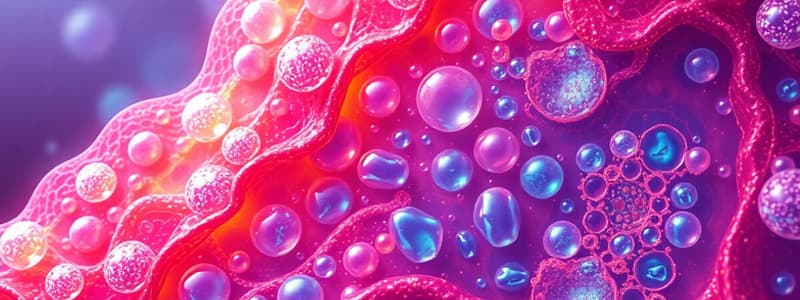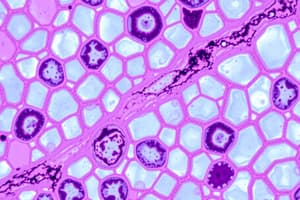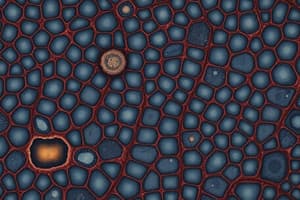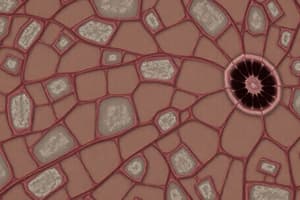Podcast
Questions and Answers
Why is stratified squamous epithelium named based on its apical surface layer rather than the basal layer?
Why is stratified squamous epithelium named based on its apical surface layer rather than the basal layer?
- The basal layer is constantly undergoing mitosis, making it difficult to classify.
- The shape of the cells in the apical layer determines the primary function of the epithelium. (correct)
- The apical surface is the only layer that contains living cells.
- The apical surface is closer to the blood supply, influencing cell morphology.
In which of the following locations would you most likely find simple squamous epithelium, and why?
In which of the following locations would you most likely find simple squamous epithelium, and why?
- Respiratory tract, to facilitate gas exchange. (correct)
- Kidney tubules, for active secretion of waste products.
- Lining of the stomach, for protection against digestive acids.
- Epidermis of the skin, to withstand abrasion.
Which type of cell junction facilitates the rapid spread of electrical impulses in the heart by allowing ion sharing?
Which type of cell junction facilitates the rapid spread of electrical impulses in the heart by allowing ion sharing?
- Adherens junctions
- Tight junctions
- Desmosomes
- Gap junctions (correct)
Which type of epithelial tissue is best suited for lining the bladder, allowing it to stretch and expand?
Which type of epithelial tissue is best suited for lining the bladder, allowing it to stretch and expand?
What primary characteristic distinguishes endocrine glands from exocrine glands?
What primary characteristic distinguishes endocrine glands from exocrine glands?
Connective tissue is characterized by which of the following features?
Connective tissue is characterized by which of the following features?
Which type of cell junction is most likely to be found in tissues that experience mechanical stress, such as the skin and heart?
Which type of cell junction is most likely to be found in tissues that experience mechanical stress, such as the skin and heart?
During embryonic development, what is the correct sequence of differentiation leading to the formation of cartilage?
During embryonic development, what is the correct sequence of differentiation leading to the formation of cartilage?
Which type of fiber in the extracellular matrix of connective tissue is known for its ability to resist tension and pulling forces, providing strength to the tissue?
Which type of fiber in the extracellular matrix of connective tissue is known for its ability to resist tension and pulling forces, providing strength to the tissue?
What is the most important function of tight junctions in epithelial tissues?
What is the most important function of tight junctions in epithelial tissues?
Which of the following pairings of epithelial tissue type and location is mismatched?
Which of the following pairings of epithelial tissue type and location is mismatched?
In areolar connective tissue, what is the primary role of fibroblasts?
In areolar connective tissue, what is the primary role of fibroblasts?
What feature would you expect to find in pseudostratified columnar epithelium that facilitates the movement of mucus?
What feature would you expect to find in pseudostratified columnar epithelium that facilitates the movement of mucus?
What is the main characteristic of reticular fibers that distinguishes them from collagen fibers?
What is the main characteristic of reticular fibers that distinguishes them from collagen fibers?
Which of the following cell types is exclusively found within cartilage tissue?
Which of the following cell types is exclusively found within cartilage tissue?
If you were analyzing a tissue sample and observed a predominance of collagen fibers arranged in a parallel fashion, which type of connective tissue would you most likely be observing?
If you were analyzing a tissue sample and observed a predominance of collagen fibers arranged in a parallel fashion, which type of connective tissue would you most likely be observing?
Which of the following is NOT a primary function of epithelial tissue?
Which of the following is NOT a primary function of epithelial tissue?
Epithelial tissues are described as avascular yet innervated. What does this imply about their structure and function?
Epithelial tissues are described as avascular yet innervated. What does this imply about their structure and function?
How does the arrangement of cells in pseudostratified columnar epithelium contribute to its function?
How does the arrangement of cells in pseudostratified columnar epithelium contribute to its function?
Cilia are commonly found in which type of epithelial tissue and what is their primary function?
Cilia are commonly found in which type of epithelial tissue and what is their primary function?
The basal lamina is a critical component of epithelial tissue. What is its primary role?
The basal lamina is a critical component of epithelial tissue. What is its primary role?
Why do epithelial tissues have a high regeneration rate, and what factor significantly contributes to this?
Why do epithelial tissues have a high regeneration rate, and what factor significantly contributes to this?
How does the shape of squamous epithelial cells contribute to their function in areas like the lining of blood vessels and air sacs of the lungs?
How does the shape of squamous epithelial cells contribute to their function in areas like the lining of blood vessels and air sacs of the lungs?
Smokers often experience a condition where the cilia in their respiratory tract are damaged or destroyed. What is a likely consequence of this damage?
Smokers often experience a condition where the cilia in their respiratory tract are damaged or destroyed. What is a likely consequence of this damage?
Which type of tissue is primarily responsible for covering body surfaces and lining cavities?
Which type of tissue is primarily responsible for covering body surfaces and lining cavities?
Which type of epithelial tissue is specialized for absorption?
Which type of epithelial tissue is specialized for absorption?
Which type of epithelial tissue is best suited for diffusion and filtration due to its thinness?
Which type of epithelial tissue is best suited for diffusion and filtration due to its thinness?
What is the primary function of epithelial tissue?
What is the primary function of epithelial tissue?
Which type of epithelial tissue is primarily involved in absorption and secretion?
Which type of epithelial tissue is primarily involved in absorption and secretion?
Which type of epithelial tissue is characterized by having a single layer of flat cells?
Which type of epithelial tissue is characterized by having a single layer of flat cells?
Which type of epithelial tissue is known for its ability to stretch and is found in the urinary bladder?
Which type of epithelial tissue is known for its ability to stretch and is found in the urinary bladder?
Which type of epithelial tissue is specialized for absorption and secretion?
Which type of epithelial tissue is specialized for absorption and secretion?
Flashcards
Tissue
Tissue
A group of closely associated cells that perform related functions and are similar in structure.
Epithelial Tissue
Epithelial Tissue
Tissue that covers body surfaces, lines cavities, and forms glands.
Functions of Epithelial Tissue
Functions of Epithelial Tissue
Protection, movement (absorption, secretion, filtration), forming slippery surfaces.
Characteristics of Epithelia
Characteristics of Epithelia
Signup and view all the flashcards
Microvilli
Microvilli
Signup and view all the flashcards
Cilia
Cilia
Signup and view all the flashcards
Types of Epithelial Tissue Layers
Types of Epithelial Tissue Layers
Signup and view all the flashcards
Shapes of Epithelial Cells
Shapes of Epithelial Cells
Signup and view all the flashcards
Stratified Squamous Epithelium
Stratified Squamous Epithelium
Signup and view all the flashcards
Simple Squamous Epithelium
Simple Squamous Epithelium
Signup and view all the flashcards
Simple Cuboidal Epithelium
Simple Cuboidal Epithelium
Signup and view all the flashcards
Pseudostratified Columnar Epithelium
Pseudostratified Columnar Epithelium
Signup and view all the flashcards
Stratified Cuboidal Epithelium
Stratified Cuboidal Epithelium
Signup and view all the flashcards
Transitional Epithelium
Transitional Epithelium
Signup and view all the flashcards
Endocrine Glands
Endocrine Glands
Signup and view all the flashcards
Tight Junctions
Tight Junctions
Signup and view all the flashcards
Gap Junctions
Gap Junctions
Signup and view all the flashcards
Connective Tissue
Connective Tissue
Signup and view all the flashcards
Mesoderm
Mesoderm
Signup and view all the flashcards
Fibroblast
Fibroblast
Signup and view all the flashcards
Chondrocyte
Chondrocyte
Signup and view all the flashcards
Types of Connective Tissue Proper
Types of Connective Tissue Proper
Signup and view all the flashcards
Collagen Fibers
Collagen Fibers
Signup and view all the flashcards
Cartilage Types
Cartilage Types
Signup and view all the flashcards
Study Notes
Tissues
- Tissues are groups of closely associated cells performing related functions and having similar structures.
- Epithelial tissue covers and lines body surfaces and forms glands.
- Connective tissue provides support.
- Muscle tissue facilitates movement.
- Nervous tissue controls bodily functions.
Epithelial Tissues
- Cover body surfaces or line body cavities.
- Form most glands.
- Functions include protection, movement across (absorption, secretion, ion transport, filtration), and forming slippery surfaces.
- Characteristics include densely packed cells and specialized cell-cell junctions.
- Epithelial cells are polar, supported by connective tissue, avascular but innervated, and regenerate at high rates.
- Surface features include microvilli (increase surface area) and cilia (aid in movement).
- Cell junctions connect adjacent cells.
- Basal lamina anchors epithelium to connective tissue.
- Epithelial tissue types are classified by cell layers (simple or stratified) and cell shape (squamous, cuboidal, or columnar).
Connective Tissue
- The most diverse and abundant tissue type.
- Includes connective tissue proper, cartilage, bone, and blood.
- Cells are separated by a large extracellular matrix.
- Connective tissues develop from mesoderm.
- Subclasses include loose and dense connective tissue, cartilage (hyaline, fibro, elastic), and bone (compact and spongy).
Muscle Tissue
- Function is movement.
- Structure is elongated muscle fibers.
- Subtypes include skeletal (voluntary), cardiac (heart), and smooth (involuntary).
Nervous Tissue
- Function is regulation/control of body functions.
- Structure includes neurons and supporting (non-conducting) cells.
Studying That Suits You
Use AI to generate personalized quizzes and flashcards to suit your learning preferences.




